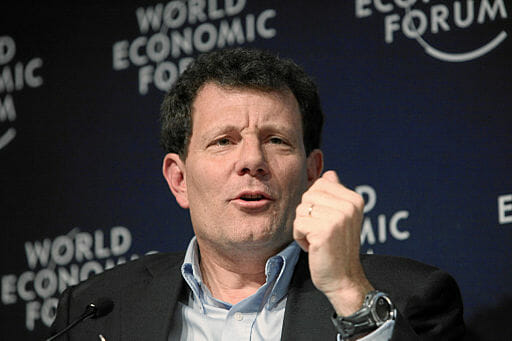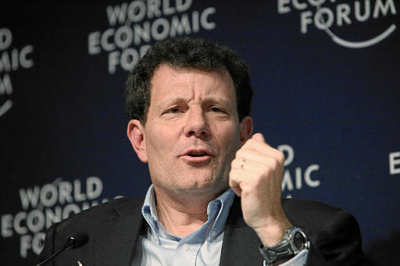The Well-Trod Path: Nick Kristof at Home


Having liberated the “better half” of the developing world from gender-based oppression and poverty, the New York Times’s fave do-gooder Nicholas Kristof and his trusty investment-banker sidekick Sheryl WuDunn have set their sights closer to home. Folks on the war-torn streets of the US of A need saving, too, so the dream team behind Half the Sky quartered production costs (although probably not grant funding) and set up shop White Saviouring right here where we can watch ‘em in action.
Well, sort of. Locations for the three-part PBS series A Path Appears (the last of which aired this week) were secret, although Kristof teased at one Chicago event in 2013 that he’d been filming locally. The conceits, however, are familiar, especially if you watched Half the Sky, or its predecessor, Milton Friedman’s Free to Choose: documentary as thinly veiled capitalist propaganda; glitterati talking heads waxing poetic on the social impact of the film’s avuncular figurehead; overly compassionate white men flitting about the globe, their wives theoretically in tow but rarely on camera. (Kristof’s innovation to the form jam-packs starlets like Olivia Wilde—or former starlets, like Mia Farrow—into each scene.) Resulting episodes offer little stage plays on the delights of neoliberal globalization—a worldview that, although unnamed, remains at the crux of each film’s agenda.
“It’s men with money,” Audrey Morrissey, of the Boston-based survivor-led organization My Life, My Choice, says. “It’s upper middle class white males from the suburbs married with a family.” She’s describing the impetus for sex trafficking in the first episode, and by extension, the driving force behind A Path Appears.
This doesn’t, however, describe the viewers. “Love hearing the stories of sex trafficking survivors,” one eager female fan enthused on Twitter before Path’s premiere. For while white men somewhat awkwardly form the moral center of the film—arresting wrong-doers, atoning for past sins, being Nick Kristof—the feminine victimization narrative appeals primarily to other women. It must be lucrative enough to have provided the rationale for the film’s drastic departure from the book of the same name. For A Path Appears, the wordy version, tracks the entrepreneurial exploits of companies in emerging markets—developing nations, poverty-stricken areas of the U.S.—and, well, elucidates their sales strategies.
The argument behind Kristof and WuDunn’s book boils down to this early, bizarre statement: “Efforts at altruism have a mixed record of success at helping others, but they have an almost perfect record of helping ourselves.” This reframing of selflessness as desirable because it is remunerative is a stupendous opening act; the book proceeds therefrom by proving the profitability of the theory. The authors argue that nonprofits, for example, while largely useless, can be helpful insofar as they emulate for-profit corporations (by, for example, accruing as much money as possible, focusing on brand awareness campaigns, and allowing clients-slash-customers to establish tiny fiscal empires of their own).
Corporations both large and small, of course, are celebrated. In one example, the authors applaud one Malawi victim of human rights abuses for her intention to purchase the first television set in her poverty-stricken village so she can charge her neighbors money to watch it.
No such applause for poor women profiting from slightly poorer folks appears in the film, but neither does the book’s economic argument. Instead, A Path Appears shows us back-to-back rescues of damsels in distress—from what we’re told is sex trafficking in Chicago (episode one), from the Haitian restavec system (episode two), and from domestic abuse in Atlanta (episode three). There are other, gentler rescues—from poverty, illiteracy, etcetera—but the real show-stoppers feature platoons of armed men swooping in, and Uncle Nick looking pleased as punch as raids transpire. In episode three, he’s even wearing a flak jacket labeled “SHERIFF.” Did you hear there’s a new one in town?
Everything in the Kristof oeuvre, Times columns included, has one thing in common: the suggestion that he somehow holds specialized knowledge about how poverty and the oppression of women operate, and how to eradicate both. He casts his films with women who seem to agree, even if his theories contradict their own experiences: Blake Lively, a starlet in the first episode, even says that she felt ignorant of how girls experience the world until Kristof explained it to her.
We are to accept this authority as the justification for the enormous funding Kristof and WuDunn receive to depict global poverty: Half the Sky’s not-for-profit Force Film Foundation raised $2.1 million in grants and donations in 2012 alone, a figure that doesn’t account for the couples’ speaking fees, book sales, or private screenings. Financial details of A Path Appears have not yet been released, but certainly the film’s sponsors—the IKEA Foundation, Hilton Worldwide, Vagisil, and others—could beat that earlier budget. After all, Kristof is the leading propagandist in the lucrative Sex Trafficking Survivor Story market, which in the U.S. not only influences evermore legislation, but commands upwards of half a billion dollars every year.
For this, Kristof may argue, is unassailable proof of the impact of his altruism: So. Much. Money.